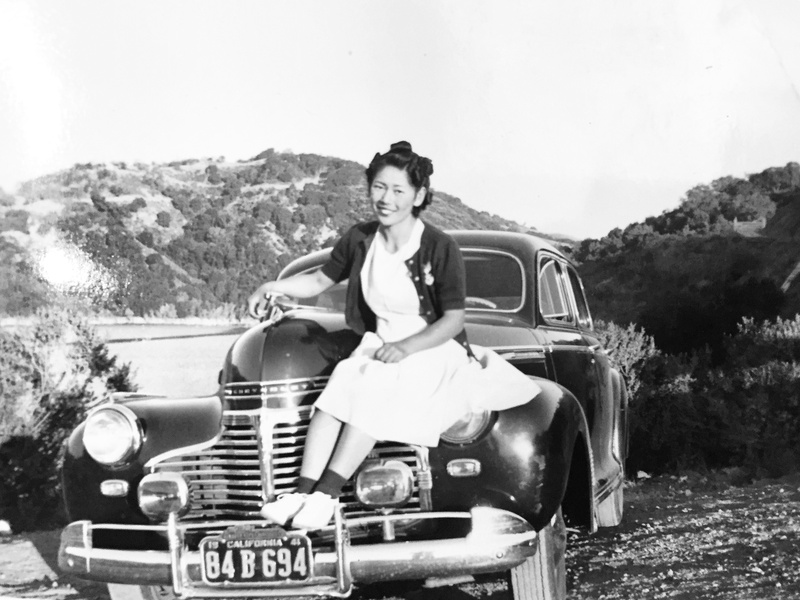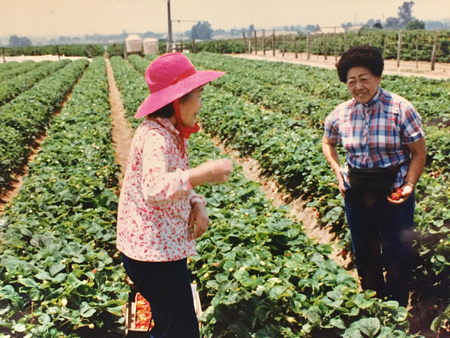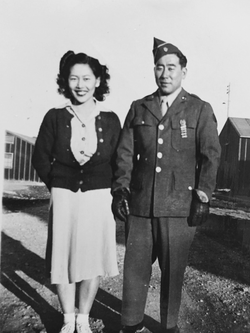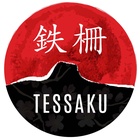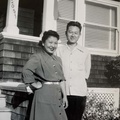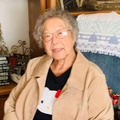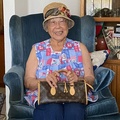“Her life experience was very American. She worked the land, she was always dirty, she’d been working since she was eight. It was that blue-collar kind of work ethic. I felt she was very American.”
—Tomiko Tommy Miyahara
I met Tommy’s granddaughter, Carly Perera, in San Francisco. It was our first time meeting in person yet our lives overlapped in coincidental ways. We both were raised in San Jose and were both working on projects to reclaim an unspoken past, piecing together fragments of stories from photos of grandparents who never spoke of their experience in camp. Lucky for Carly, her grandmother kept everything, even the letter that stated that they were going to camp. Tommy kept a diary and wrote nearly everyday, a goldmine for archivists and historians.
Tommy was a tomboy, an all-American lady who farmed and played baseball. Carly describes her as blunt and sassy yet graceful and refined. But she had a run-in with tragedy in her twenties. Her first child, Janice, died in camp from spinal meningitis and it would seem as if Tommy would never fully recover from such a loss. Carly describes the abrupt switch in her grandmother’s diary. “All her entries up until then were very boring but after her child died, it was like a valve had broken loose,” she says. The idea of inadequate medical facilities haunted Tommy for the rest of her life: Were the camp conditions to blame, or would she have succumbed to the disease regardless? Tommy was convinced that had they been living a free, normal life, Janice might have survived.
As we often see our grandparents as they exist only in their familial role, Carly’s project revealed her grandmother in a different light. She discovered that like herself, Tommy was a woman with her own hopes and dreams, and while they were put on hold, she exuded quiet resilience and grace in the face of insurmountable loss.
Tommy lives on digitally, through @tommykm on Instagram.
* * * * *
What was your relationship like with your grandmother?
She was quiet and I think in our family there were things we didn’t talk about and camp was one of them. They didn’t really talk about it. I was close as a grandchild. She didn’t talk about herself that much. My grandfather died a year before I was born, so I just knew her as my grandmother. We didn’t call her bachan actually, it’s kind of interesting. The other half of our family called her bachan and my mom told us to call her Grandma. And she would always sign her cards in quotation marks “Tommy.”
She was very American. You can see it in the way she dressed, the way she acted, she was a tomboy. She worked all the time, she danced the Charleston, the way she talked was very American. It was very 1940s proper American. She had a smart mouth back then.
So which generation is she?
She was born in San Jose. She met her husband Frank in Campbell. They both were Nisei. She worked the land in Watsonville or San Jose. They would go wherever there were crops.
How did she meet her husband?

I’m still trying to get the story straight on that because he’s a few years younger. I know my grandmother was a member of the Japanese American Citizens League so I’m thinking that’s where they met. I know they were both supposed to marry somebody else, and they didn’t.
They had arranged marriages?
It was arranged with somebody else, and they were dating and then of course the war sped up everything. They told their parents, “We’re going to marry each other.”
Was the marriage frowned upon or were the parents okay with it?
I think it was very much frowned upon. And this is all secondhand from my mother but I think that my grandmother did not get along with her in-laws, especially his mother, who was a very harsh woman. Frank’s father was kind of a jokester and I think his mom was very critical of Tommy. For better or worse they were interned very quickly after that and they were separated.
How old were they?
Tommy was in her 20s, either 23 or 24. And Frank was two years younger, so 21. I don’t know if he chose what happened but he was interned with Tommy’s immediate family and they went to Heart Mountain. Frank’s family were mostly in Gila River and Poston. They were all spread out. But Frank went with Tommy.
And he got along with her family?
I’m actually not sure if they got along. When I read her diary it was very much to the point, not really divulging much or herself. I think it might have been a typical marriage in that he went out a lot. In the camps, it’s such a different way of living. Usually when you marry someone you become a unit and only have one place to live but there they’re just waiting. And her entries were so boring. “Dry wind, coming from the South.” “Washed clothes.” “Played baseball.” She talks about the long lines for laundry. You see the monotony of every day.
But there was a riot that happened in Santa Anita, some kind of uprising. In the diary she wrote that entry in detail, super tiny in cursive. So it was almost the only entry that she wrote that way, and I think it was because of the fear that things would get confiscated. Someone attacked a Japanese man or a Japanese man attacked the cops.
After they lived in Santa Anita, what happened?
They took the train from Santa Anita to Heart Mountain, which I think was five days in total. And she would write about these landscapes, and for me I was thinking about how she’s on a train looking at all of these beautiful places that she’s not free to go see. It was kind of heartbreaking to me.
Once they were there, it was about a year before she got pregnant with her first baby. And once that baby was born her entires became, “Oh my purpose, my life,” which is what I’m sure what all new mothers feel when they have a baby.
Janice was born in 1943. And she became sick four or five months later. Tommy went to the hospital in the camp and they tried to find out what it was. Eventually she declined really, really fast, after about two months. They found out it was spinal meningitis and I’m not sure if she died because there weren’t medical treatments in camp or if outside if it was even treatable, I don’t know. I know that my family told me when I was younger that she died because there wasn’t adequate medical treatment. So I think my grandmother always felt like it was an injustice. When she lost her baby, her diary entries became very long and it was the cycle of grief. Just repeatedly, “I miss my daughter.” It was a good year that she wrote entries like that.
Really heartbreaking.
First child, first grandchild. When the baby died, Frank was shocked. In his journal entries later he has his mantra of, “I love Janice, I love Janice.” It was sad to see both of them process the loss of this baby. She didn’t talk about Janice actually. I only know about her through my mom. And my grandma had this huge photo of her on her bedside table but it wasn’t something that we talked about.
Then Frank missed the birth of his son, his second child. Frank had an injury in his arm and it didn’t get treated so it spread to his hip and he eventually needed a full-body cast. He was in the hospital for a year and a half, 1944 through ’45. So he missed the birth and the first year of that child’s life. But I think he also made really good friendships with the nurses in the hospital, so they may have given him a camera so he could see photos of his son.
*This article was originally published on Tessaku on February 22, 2017.
© 2017 Emiko Tsuchida


